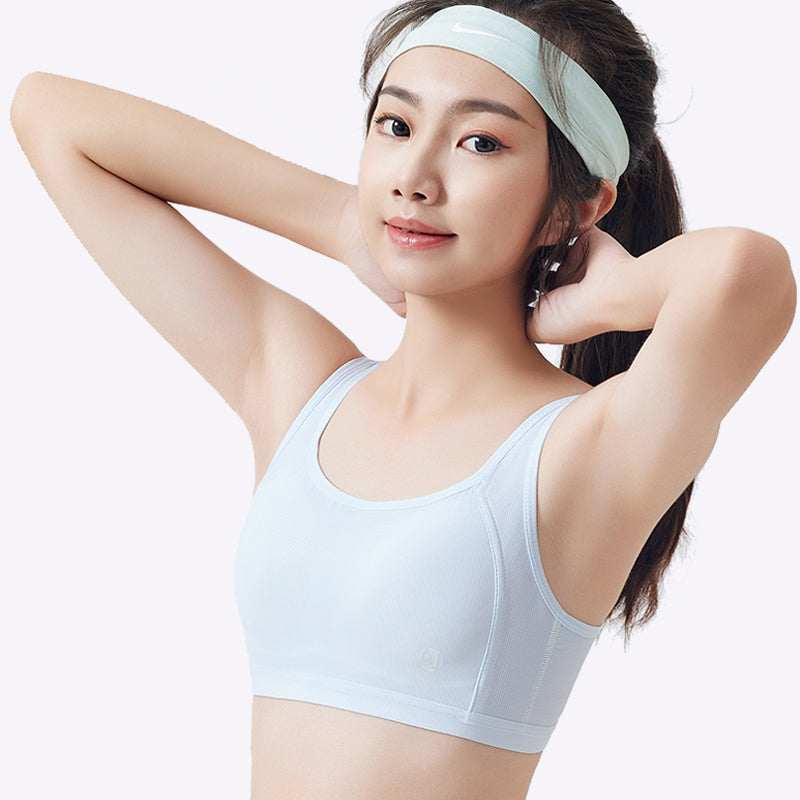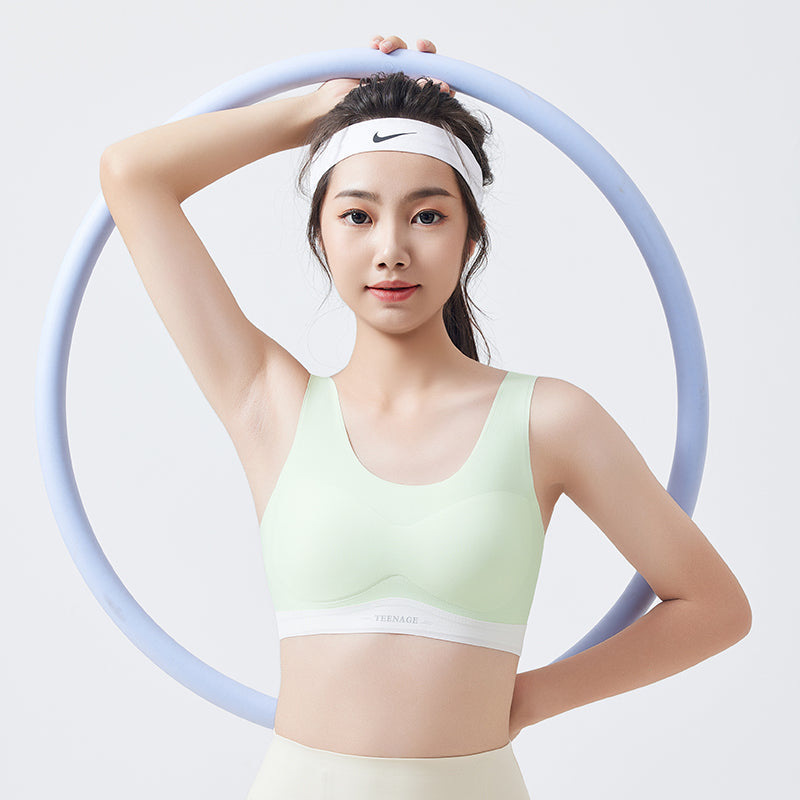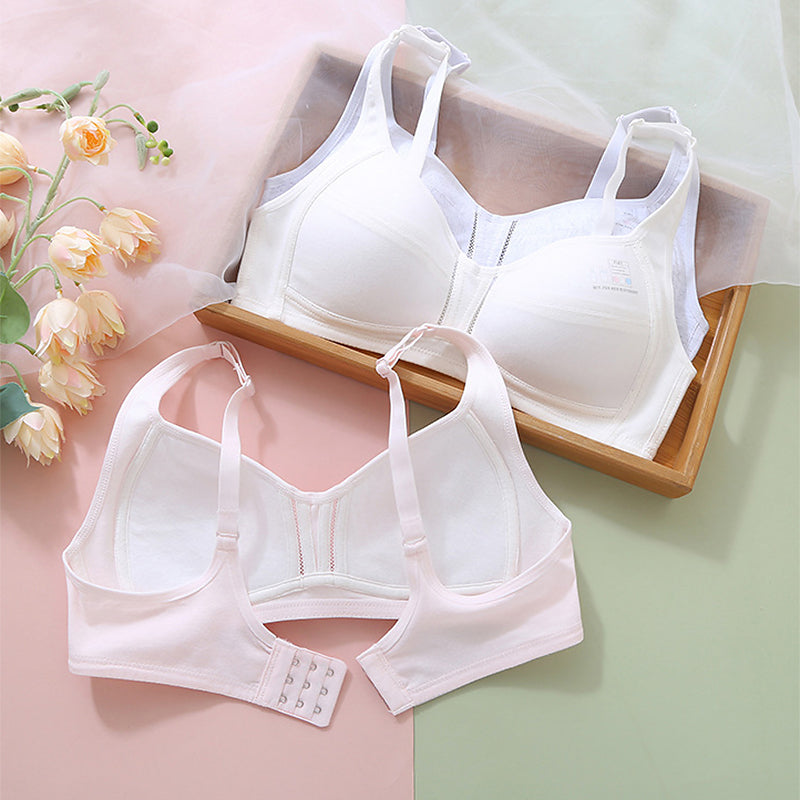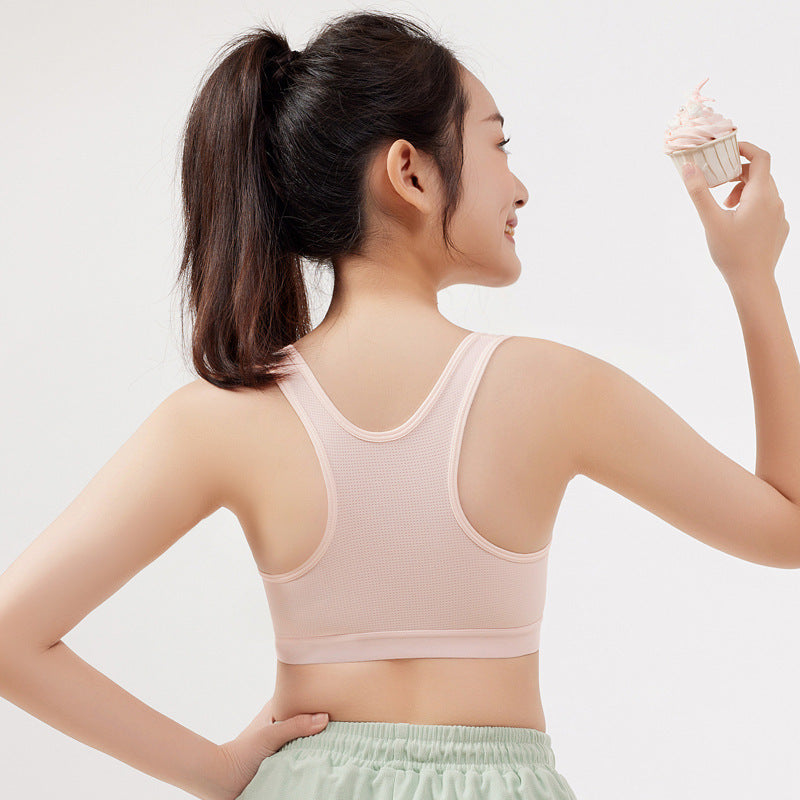How to Talk About First Bras — Comfort, Consent, Confidence
Discussing a first bra can be a delicate topic for everyone involved. Parents wonder what to say (and what not to say). Girls may feel curious one minute and shy the next. The goal isn’t to get the “perfect” words—it’s to create a calm, respectful space where comfort guides the choices. This guide shares ready-to-use scripts, a simple checklist for joint decisions, and do/don’t phrasing you can keep on your phone. You’ll also find gentle ways to bring up the topic, how to handle common questions, and what to do next once you’ve chosen a stage and size.
Why this guide is different: It isn’t a sizing tutorial (we already have that). It’s about communication and wellbeing—helping you talk through needs and options at her pace, while you use our stage system (First Bloom → Growing Grace → Confident Bloom) as a simple, non-judgmental framework. For a complete overview of stages, see our Stages Overview. For the earliest options, see First Bloom (Ages 6–11).
1) Signs she might be ready (and how to notice without prying)
Every child develops at their own pace. Rather than setting a specific age, look for comfort cues—small signals that suggest the conversation could help:
- She tugs at shirts for smoother lines or mentions “you can see things” under a tee.
- She’s curious about what older friends or siblings wear.
- She wants more privacy in changing spaces or after PE.
- She’s more active and asks for something that “stays put.”
- She brings it up directly (even casually—“I think I want one”).
If you see two or more of these, it’s a great time to start a gentle chat. If you see none, there’s no rush. Keep this guide handy for when the moment naturally arises.
2) Start the conversation: low-pressure openers you can say today
Use everyday moments (such as laundry, packing for a school trip, or uniform shopping) to maintain a practical tone. Try one of these openers:
-
Neutral option (any parent/caregiver):
“I’m updating our basics for the new term. Do you want to look at soft, lightweight first bras or tops that feel comfy under uniforms?” -
Comfort-first angle:
“Some kids like a smooth layer under T-shirts or during PE. If that sounds useful, we can explore soft options together—no pressure.” -
Choice & privacy:
“If you ever want to try a first bra, we can browse online together or I can add a couple of options to the next order and you pick in private.” -
For a text message (if she prefers messaging):
“Hey! Doing a basic restock. Want to check out some super-soft first bras tonight? If not now, we can wait—totally your call.”
What these have in common: They’re short, non-medical, and framed around comfort and choice, not body commentary.
3) Words that help (and words to skip)
Do say
- “soft,” “breathable,” “gentle,” “stays put,” “feels comfy,” “you choose,” “we can try and see.”
- “Stage” language: “First Bloom is the lightest feel; it’s like a comfy layer.”
- “Fit” language: “It should sit flat and feel easy when you reach up or twist.”
Avoid saying
- “mature,” “grown-up body,” “you look older now,” “you need to hide that.”
- Comments about size, shape, or comparison to siblings/friends.
- Anything that sounds like a deadline (“It’s time for a bra at your age”).
Keeping the focus on how something feels rather than how something looks helps kids stay tuned to their own comfort.
4) Scripts you can use (word-for-word)
A) The very first chat
Some people prefer a soft, barely-there layer under T-shirts—especially for school or PE. If you want to try one, we can start with the lightest level, so it just feels comfortable. If not today, we can come back to it any time.
B) When she’s unsure or shy
We can order two or three soft options, and you decide at home privately. If none are suitable, we return them—completely fine.
C) For more active days
You mentioned straps moving in PE. There’s a style with a slightly more stable band that still feels soft. Want to try that for sports days only?
D) If she’s excited and wants control
Great! You lead. We’ll measure the underbust once, choose the lightest stage to start, and you pick the fabric you prefer. I’m here if you want help.
E) When a guardian isn’t sure what to say
I’m learning as we go. You can tell me what feels comfortable, and we’ll adjust. Comfort is the goal.
5) The joint decision checklist (make choices together, not for her)
Print or save this in your notes app and run through it with her:
Measure & Map
- We measured underbust (cm preferred).
- Mapped to the brand size and looked at First Bloom / Growing Grace / Confident Bloom.
- Decided which stage fits her day (lightest feel vs steadier band vs polished support).
Try & Test
- Tried on at home, moved around: reach up, twist, deep breath.
- The band sits flat, the straps stay put after movement, and the front feels smooth.
Choose & Keep
- Picked the style/fabric she likes wearing, not just what looks nice.
- Kept labels minimal or chose printed/soft tags if she’s sensitive.
- Agreed on when she’ll wear it (uniform days, PE, weekends).
Review & Re-measure
- After a few weeks, we’ll re-check fit and comfort.
- We can try a different cut at the same stage before jumping to the next.
Link for deeper background: Stages Overview. For the gentlest stage, browse First Bloom.
6) Common scenarios—and gentle ways to respond
Scenario 1: “I don’t want anyone to notice.”
“Let’s choose a super-smooth style with simple lines. We’ll make sure it feels light and it won’t show under a uniform.”
Scenario 2: “This feels itchy.”
“Okay—comfort is the rule. We’ll try a softer fabric or a style with fewer seams. We can also cut tags or pick printed labels.”
Scenario 3: “It keeps moving in PE.”
“We can try a similar style with slightly closer strap placement or a wider band to help it stay put—still soft, still wireless.”
Scenario 4: “I don’t like the word ‘bra.’”
“No problem. We can call it a ‘soft top’ or ‘vest.’ You choose the word that feels best.”
Scenario 5: “What if friends say something?”
“You never have to explain your underwear. If you want a line to say, try: ‘It’s just comfy for me.’ Short and done.”
Scenario 6: “Can I pick the fabric?”
“Absolutely. You get final say—cotton cozy, silky Modal/TENCEL™, or even silk-lined if you want extra smoothness.”
7) Shopping plan: minimize stress, maximize choice
At home first. Browse together online, favorite a few items, and order two or three options within the same stage. Home try-ons are calmer, especially for first-timers.
Limit the variables. For a first round, keep the neckline and color simple and test one change at a time (e.g., strap placement) so she can feel the difference.
Set expectations. Say up front: “If none are right, that’s okay—we’ll return them and try again.” Having a no-pressure exit reduces anxiety.
For in-store shopping. Ask for a quiet fitting time, bring a tee or uniform top to check the lines, and keep the conversation practical (“Does it sit flat?”) instead of focusing on appearance.
8) The do/don’t list (clip and save)
Do
- Say “How does it feel?” more than “How does it look?”
- Let her choose words (“bra,” “top,” “vest”).
- Keep pace slow; you can pause and revisit anytime.
- Re-measure each term or after noticeable growth has occurred.
- Celebrate feedback: “Thanks for telling me—that helps us choose better.”
Don’t
- Compare bodies (to siblings, friends, yourself).
- Tie the conversation to maturity or “looking grown up.”
- Force a stage jump; try another cut in the same stage first.
- Use bribes or jokes that might feel embarrassing.
- Make it a public errand unless she wants that.
9) For different family setups (every home is different)
Fathers/guardians:
If you’re not sure how to start, text first: “I’m ordering basics—want to choose a soft top together?” Offer privacy and the option to include another trusted adult if she prefers.
Blended families:
Decide who she’s most comfortable talking to; the other adults can support with ordering and practicalities. Keep communication light and aligned.
Neurodivergent kids or anxiety-prone teens:
Use visuals (simple icons or checklists), offer more time for try-ons, and minimize sensory triggers (tags, seams)—option-reduce: two choices at a time, both acceptable.
Cultural/religious considerations:
Use language that respects your family’s values—emphasize modesty, comfort, and health. The stage system is neutral and can be viewed as a practical layering approach.
10) Comfort-first care (so today’s good fit stays good)
Once she finds a comfortable piece, protect that comfort:
- Wash in cool, gentle (or hand-wash) water with a mild detergent, avoiding fabric softener.
- Use a mesh laundry bag to prevent snags; air-dry to maintain elasticity.
- If a style is silk-lined, blot and dry in shade; light steam on the reverse is fine.
These habits keep softness and shape—so she doesn’t have to re-adjust mid-day. (For details, see our Care & Material guide.)
11) FAQs you can answer in one sentence
At what age is the right time for a first bra?
There’s no single age—comfort cues and daily routine matter most.
How should it feel?
The band sits flat, straps stay put, and she can move freely; if she forgets she’s wearing it, it’s right.
What if she’s between sizes?
Choose the larger band for comfort and fine-tune with strap adjustments.
Is “padding” required?
Not at all. Start with the lightest feel; add lightly padded options only if she asks for smoother lines.
What if we can’t agree?
Press pause. Revisit next month or try a different cut in the same stage; her comfort is the compass.
12) A micro-script library (copy/paste to Notes)
-
Ask without pressure:
“Want to try a super-soft top under your uniforms? If not, we can wait.” -
Offer options:
“We can browse together, I can shortlist and you pick, or I can order a few and you try in private. Your choice.” -
Normalize changing your mind:
“If it’s not comfy, we return it. No big deal.” -
Reframe fit:
“We’re chasing ‘forget it’s there’ comfort, not a specific look.” -
Set next steps:
“Let’s measure once, pick the lightest stage, and test one style this week.”
13) Putting it all together: a 10-minute plan
- Pick the moment: After dinner or during a calm errand.
- Say one sentence: “Some kids like a soft layer under tees—want to try one?”
- Measure once: Underbust with a soft tape (cm).
- Pick a stage: For first-timers, First Bloom.
- Choose two styles: Same stage, different strap/band approach.
- Try at home: Reach, twist, breathe.
- Ask one question: “Do you forget it’s there?”
- Decide together: Keep what she likes, return the rest.
- Save care steps: Cool wash, mild detergent, air-dry.
- Check back later: After a few weeks, ask, “Still comfy?” If not, tweak the style or stage.
14) When to revisit the conversation
- After growth spurts or the start of new sports seasons.
- When she mentions adjusting during PE or long classes.
- If she’s experimenting with fitted tops and wants a smoother line.
- When she initiates (even casually, even by text).
The stage system is designed to grow with her. You can keep one favorite style and add another for different days—there’s no “one forever” solution; there’s “what works now.”
Closing: Comfort, consent, confidence
A first bra isn’t a test or a deadline. It’s a small, practical choice that can boost confidence when approached carefully. Keep language simple, focus on her comfort, and go at her pace. If she’s new to the idea, start with the lightest stage; if she’s more active or wants fewer readjustments, try a slightly sturdier band—all without jumping to rigid structure. When unsure, let comfort guide you and revisit later. That’s how “first bra chats” become just another calm, everyday decision you make together.









